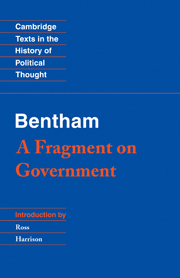Book contents
- Frontmatter
- Contents
- Introduction
- Principal events in Bentham's life
- Bibliographical note
- Note on the text
- A Fragment on Government
- Preface
- Introduction
- CHAPTER I Formation of Government
- CHAPTER II Forms of Government
- CHAPTER III British Constitution
- CHAPTER IV Right of the Supreme Power to Make Laws
- CHAPTER V Duty of the Supreme Power to Make Laws
- Appendix A From the Preface to the second edition
- Appendix B From a draft Preface
- Index
- Cambridge Texts in the History of Political Thought
Introduction
Published online by Cambridge University Press: 05 June 2012
- Frontmatter
- Contents
- Introduction
- Principal events in Bentham's life
- Bibliographical note
- Note on the text
- A Fragment on Government
- Preface
- Introduction
- CHAPTER I Formation of Government
- CHAPTER II Forms of Government
- CHAPTER III British Constitution
- CHAPTER IV Right of the Supreme Power to Make Laws
- CHAPTER V Duty of the Supreme Power to Make Laws
- Appendix A From the Preface to the second edition
- Appendix B From a draft Preface
- Index
- Cambridge Texts in the History of Political Thought
Summary
In his own copy of the Fragment on Government, Jeremy Bentham made the handwritten note that ‘this was the very first publication by which men at large were invited to break loose from the trammels of authority and ancestor-wisdom on the field of law’. It is a young man's book. It is a fresh book, fresh with energy, ideas, and hope. It is a critical book, surveying the established and uncongenial world and determined to show how it might do better. The legal and political world is to be constructed anew from first principles. As Bentham noted in a manuscript written shortly after the Fragment, he had found, on commencing study of the law, ‘the various rights and duties of the various classes of mankind jumbled together in one immense and unsorted heap: men ruined for not knowing what they are neither enabled nor permitted to learn: and the whole fabric of jurisprudence a labyrinth without a clew’. The only way he saw to ‘cleanse the Augean stable’ was ‘to pour in a body of severe and steady criticism and to spread it over the whole extent of the subject in one comprehensive unbroken tide’. So the current state of the law he took to be a mass of filth – in another place he commented that training in the law was like being asked to roll in the contents of a night cart – and this all had to be flushed away by new thought and new criticism.
- Type
- Chapter
- Information
- Bentham: A Fragment on Government , pp. vi - xxiiiPublisher: Cambridge University PressPrint publication year: 1988



